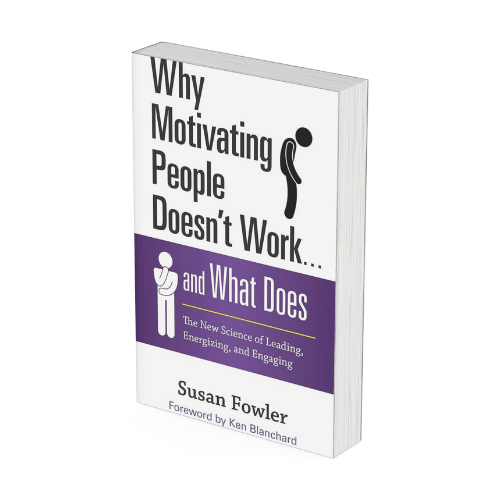Why Motivating People Doesn’t Work and What Does
by Susan Fowler
Susan Fowler is a leadership and motivation expert who has spent decades researching what drives human behaviour. She is a senior consulting partner at The Ken Blanchard Companies and has worked with organizations worldwide to improve workplace motivation and engagement. Fowler’s work is rooted in self-determination theory, which focuses on how people develop intrinsic motivation. She believes that traditional motivation techniques—such as rewards, incentives, and pressure—fail in the long run and that leaders need a new approach to inspire people. She challenges outdated management strategies through her books, keynotes, and workshops and provides a science-backed framework for sustainable motivation.
Why Motivating People Doesn’t Work and What Does
Susan Fowler’s Why Motivating People Doesn’t Work and What Does challenges the traditional ways businesses and leaders try to motivate employees. She argues that external motivators like rewards, bonuses, and fear-based tactics don’t create long-term engagement or performance. Instead, they often lead to short-term compliance and burnout.
Fowler’s book is built on the foundation of self-determination theory, which identifies three psychological needs that drive real, lasting motivation:
- Autonomy – The need to feel like we have control over our choices.
- Relatedness – The need to feel connected to others and have meaningful relationships.
- Competence – The need to feel capable and effective in what we do. She explains that when these three needs are met, people become intrinsically motivated, meaning they work hard because they genuinely want to—not because they are pressured, bribed, or threatened. The problem with most workplace motivation strategies is that they focus on controlling employees rather than supporting their natural drive to succeed.
Fowler also introduces the Optimal Motivation Framework, which helps leaders shift from external motivators (carrots and sticks) to an approach that nurtures employees’ internal motivation. She provides practical steps to help leaders have better motivation conversations, create an environment where employees feel valued, and move away from outdated management tactics that rely on pressure and rewards.
At its core, the book argues that sustainable motivation isn’t something leaders do to people—it’s something they create the conditions for. The best motivation comes from within, and the role of a leader is to cultivate an environment where people can thrive.
My Thoughts on “Why Motivating People Doesn’t Work and What Does”
I love how Susan Fowler flips the traditional idea of motivation.
Many businesses still rely on old-school tactics like bonuses, threats, and forced competition to get results, but this book proves that those methods don’t work in the long run. It makes total sense—when people feel pressured to perform, they might comply for a while but eventually burn out or disengage.
What stood out to me was the emphasis on autonomy, relatedness, and competence. These are basic human needs, and people naturally become more engaged when they’re met. Yet, many workplaces kill motivation by micromanaging employees, creating toxic environments, or failing to provide growth opportunities. Fowler’s message is clear: people don’t need to be “motivated” by force. They need an environment where they can motivate themselves.
It’s packed with practical advice.
I also appreciate that this book isn’t just theory. Fowler doesn’t just tell leaders what not to do; she gives a roadmap for what does work. Her Optimal Motivation Framework is something that every leader, coach, and manager should be using. Instead of manipulating employees with external rewards, leaders should be asking:
Are my employees making choices that align with their values? (Autonomy)
Do they feel connected to their colleagues and work? (Relatedness)
Are they given opportunities to learn and grow? (Competence)
Another thing I love about this book is how applicable it is beyond the workplace.
Whether you’re a manager, a coach, a therapist, or a parent, understanding real motivation is crucial. It’s about shifting from control to support, from pressure to empowerment.
That being said, making this shift isn’t easy. It’s deeply ingrained in most workplaces to use rewards and punishments as motivators. It takes effort to break these habits and start leading in a way that fosters authentic engagement. But the payoff is worth it. Motivated people are not just more productive—they’re happier, more creative, and more committed.
This book is a wake-up call for anyone still relying on outdated motivation techniques. Fowler’s insights are invaluable if you want to build a team or organization where people are engaged for the right reasons.
I encourage clients and colleagues to incorporate the teachings from “Why Motivating People Doesn’t Work and What Does.”
Here are key lessons I think coaches, therapists, and leaders should take from this book:
Stop relying on rewards and punishments.
They create short-term compliance, not long-term engagement.
Focus on autonomy. Give people the freedom to make choices that align with their values. Micromanagement kills motivation.
Create a sense of belonging. People need to feel connected to their work and colleagues to stay engaged.
Help people develop competence. Learning and growth are major drivers of intrinsic motivation. Give employees opportunities to improve their skills.
Have better motivation conversations. Instead of pushing people with external rewards, help them connect their work to what truly matters to them.
Recognize the difference between compliance and commitment. Just because someone follows orders doesn’t mean they’re truly engaged.
Lead with support, not control. The best leaders create an environment where people can thrive naturally.
Understand that motivation is not a one-time fix. It’s an ongoing process of nurturing people’s psychological needs.
Apply these principles beyond work. These ideas aren’t just for the workplace—parents, teachers, and coaches can all benefit from understanding true motivation.
If we can start shifting the way we think about motivation, we’ll create healthier, more productive workplaces and relationships.
In Summary
Why Motivating People Doesn’t Work and What Does is a game-changer for anyone in leadership, coaching, or personal development. Susan Fowler proves that traditional motivation tactics—like rewards and pressure—fail in the long run and instead offer a framework based on autonomy, relatedness, and competence. If we want real engagement, we must stop “motivating” people and create environments where they can motivate themselves. This book is a must-read for anyone who wants to inspire lasting commitment and drive.
Why Motivating People Doesn’t Work and What Does
by Susan Fowler
Susan Fowler is a leadership and motivation expert who has spent decades researching what drives human behaviour. She is a senior consulting partner at The Ken Blanchard Companies and has worked with organizations worldwide to improve workplace motivation and engagement. Fowler’s work is rooted in self-determination theory, which focuses on how people develop intrinsic motivation. She believes that traditional motivation techniques—such as rewards, incentives, and pressure—fail in the long run and that leaders need a new approach to inspire people. She challenges outdated management strategies through her books, keynotes, and workshops and provides a science-backed framework for sustainable motivation.
Why Motivating People Doesn’t Work and What Does
Susan Fowler’s Why Motivating People Doesn’t Work and What Does challenges the traditional ways businesses and leaders try to motivate employees. She argues that external motivators like rewards, bonuses, and fear-based tactics don’t create long-term engagement or performance. Instead, they often lead to short-term compliance and burnout.
Fowler’s book is built on the foundation of self-determination theory, which identifies three psychological needs that drive real, lasting motivation:
- Autonomy – The need to feel like we have control over our choices.
- Relatedness – The need to feel connected to others and have meaningful relationships.
- Competence – The need to feel capable and effective in what we do. She explains that when these three needs are met, people become intrinsically motivated, meaning they work hard because they genuinely want to—not because they are pressured, bribed, or threatened. The problem with most workplace motivation strategies is that they focus on controlling employees rather than supporting their natural drive to succeed.
Fowler also introduces the Optimal Motivation Framework, which helps leaders shift from external motivators (carrots and sticks) to an approach that nurtures employees’ internal motivation. She provides practical steps to help leaders have better motivation conversations, create an environment where employees feel valued, and move away from outdated management tactics that rely on pressure and rewards.
At its core, the book argues that sustainable motivation isn’t something leaders do to people—it’s something they create the conditions for. The best motivation comes from within, and the role of a leader is to cultivate an environment where people can thrive.
My Thoughts on “Why Motivating People Doesn’t Work and What Does”
I love how Susan Fowler flips the traditional idea of motivation.
Many businesses still rely on old-school tactics like bonuses, threats, and forced competition to get results, but this book proves that those methods don’t work in the long run. It makes total sense—when people feel pressured to perform, they might comply for a while but eventually burn out or disengage.
What stood out to me was the emphasis on autonomy, relatedness, and competence. These are basic human needs, and people naturally become more engaged when they’re met. Yet, many workplaces kill motivation by micromanaging employees, creating toxic environments, or failing to provide growth opportunities. Fowler’s message is clear: people don’t need to be “motivated” by force. They need an environment where they can motivate themselves.
It’s packed with practical advice.
I also appreciate that this book isn’t just theory. Fowler doesn’t just tell leaders what not to do; she gives a roadmap for what does work. Her Optimal Motivation Framework is something that every leader, coach, and manager should be using. Instead of manipulating employees with external rewards, leaders should be asking:
Are my employees making choices that align with their values? (Autonomy)
Do they feel connected to their colleagues and work? (Relatedness)
Are they given opportunities to learn and grow? (Competence)
Another thing I love about this book is how applicable it is beyond the workplace.
Whether you’re a manager, a coach, a therapist, or a parent, understanding real motivation is crucial. It’s about shifting from control to support, from pressure to empowerment.
That being said, making this shift isn’t easy. It’s deeply ingrained in most workplaces to use rewards and punishments as motivators. It takes effort to break these habits and start leading in a way that fosters authentic engagement. But the payoff is worth it. Motivated people are not just more productive—they’re happier, more creative, and more committed.
This book is a wake-up call for anyone still relying on outdated motivation techniques. Fowler’s insights are invaluable if you want to build a team or organization where people are engaged for the right reasons.
I encourage clients and colleagues to incorporate the teachings from “Why Motivating People Doesn’t Work and What Does.”
Here are key lessons I think coaches, therapists, and leaders should take from this book:
Stop relying on rewards and punishments.
They create short-term compliance, not long-term engagement.
Focus on autonomy. Give people the freedom to make choices that align with their values. Micromanagement kills motivation.
Create a sense of belonging. People need to feel connected to their work and colleagues to stay engaged.
Help people develop competence. Learning and growth are major drivers of intrinsic motivation. Give employees opportunities to improve their skills.
Have better motivation conversations. Instead of pushing people with external rewards, help them connect their work to what truly matters to them.
Recognize the difference between compliance and commitment. Just because someone follows orders doesn’t mean they’re truly engaged.
Lead with support, not control. The best leaders create an environment where people can thrive naturally.
Understand that motivation is not a one-time fix. It’s an ongoing process of nurturing people’s psychological needs.
Apply these principles beyond work. These ideas aren’t just for the workplace—parents, teachers, and coaches can all benefit from understanding true motivation.
If we can start shifting the way we think about motivation, we’ll create healthier, more productive workplaces and relationships.
In Summary
Why Motivating People Doesn’t Work and What Does is a game-changer for anyone in leadership, coaching, or personal development. Susan Fowler proves that traditional motivation tactics—like rewards and pressure—fail in the long run and instead offer a framework based on autonomy, relatedness, and competence. If we want real engagement, we must stop “motivating” people and create environments where they can motivate themselves. This book is a must-read for anyone who wants to inspire lasting commitment and drive.
“In the middle of difficulty lies opportunity.”
Recent Thoughts
Stay with the Feeling
I see it every week in the clinic, and I recognise it in myself. The moment a feeling squeezes, we reach for the
When Your Feelings Flash Like a Dashboard Light
Understanding Your Inner Emotional Compass I still remember the first time the oil light flashed during a late-night drive from a workshop, tired




